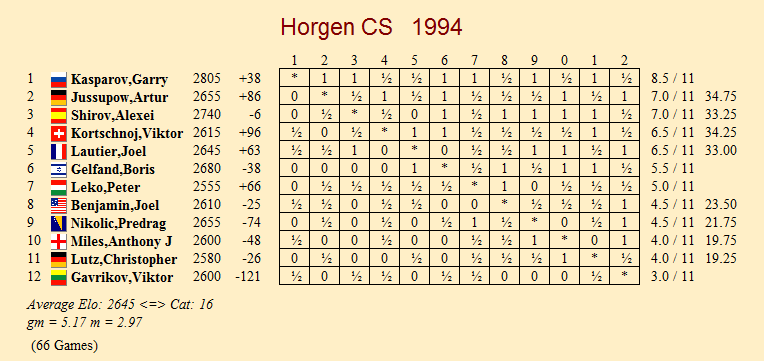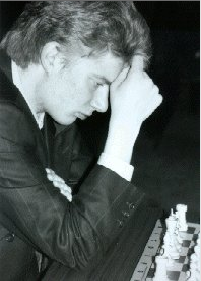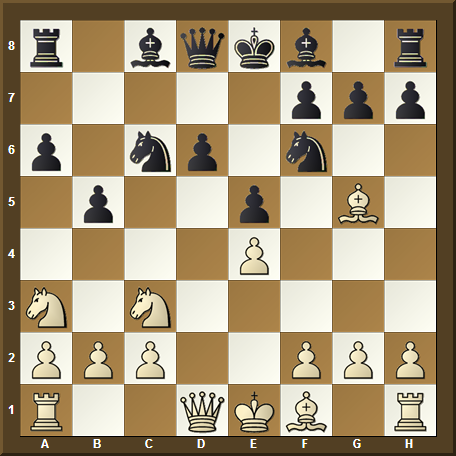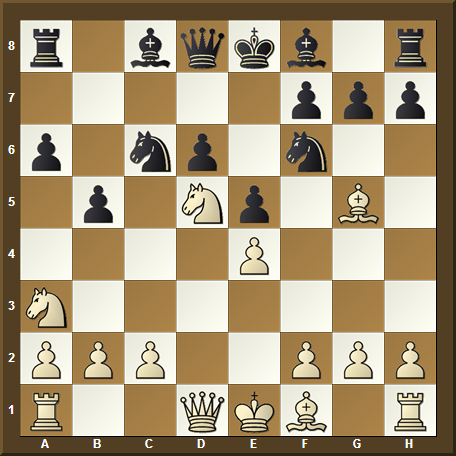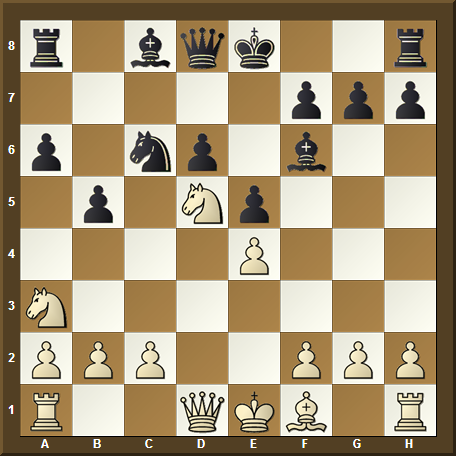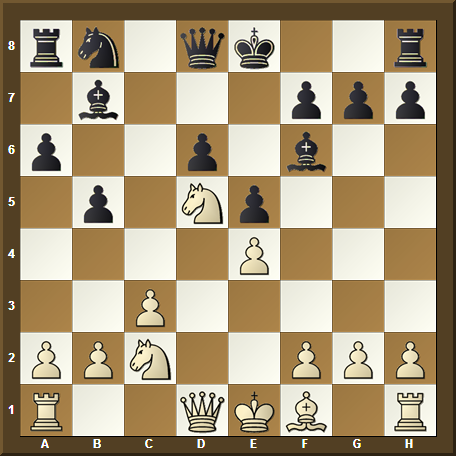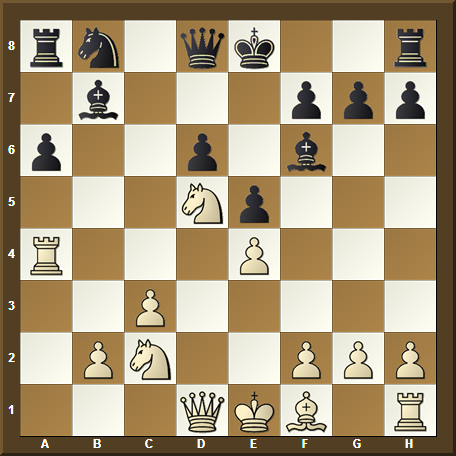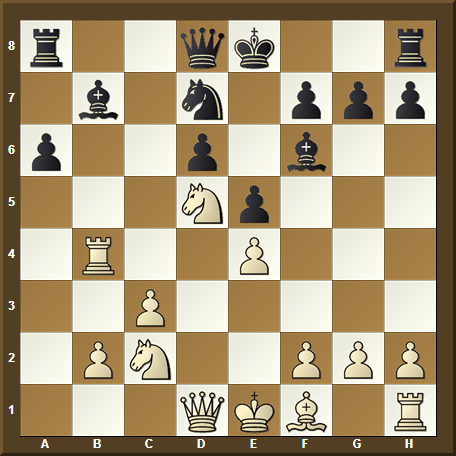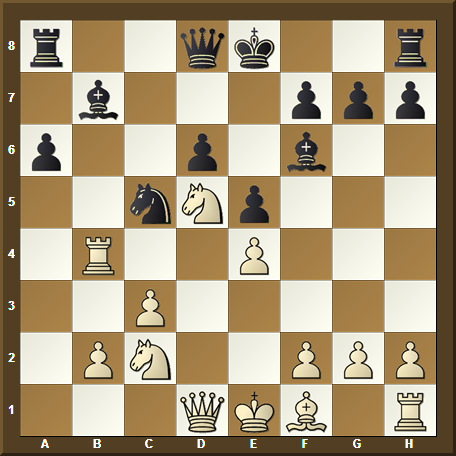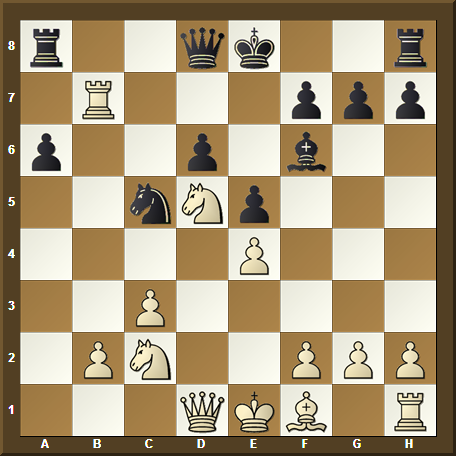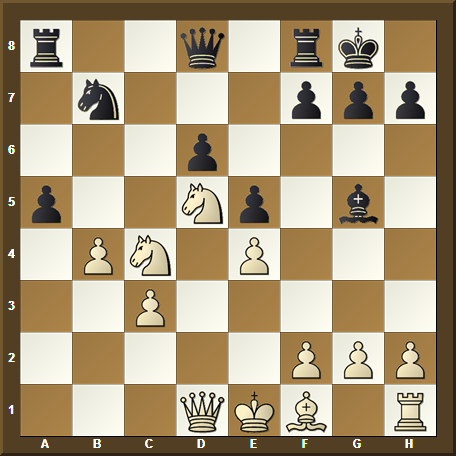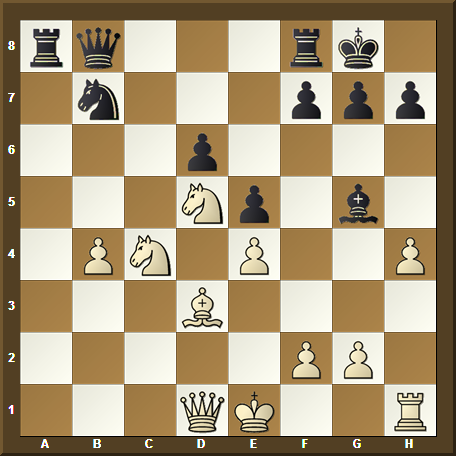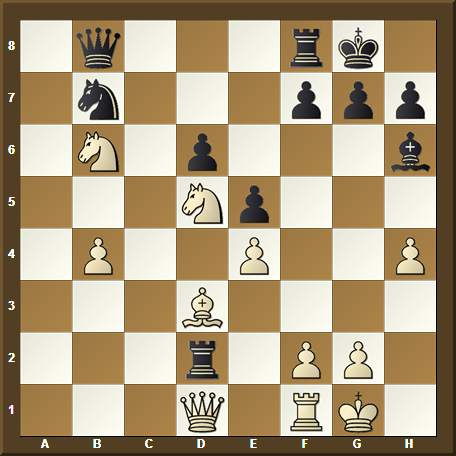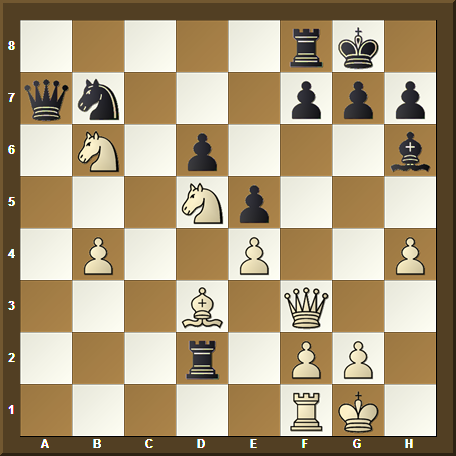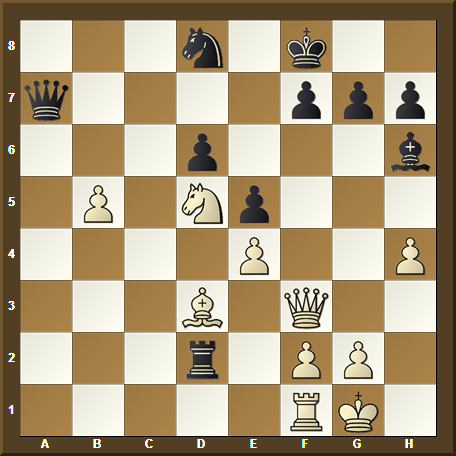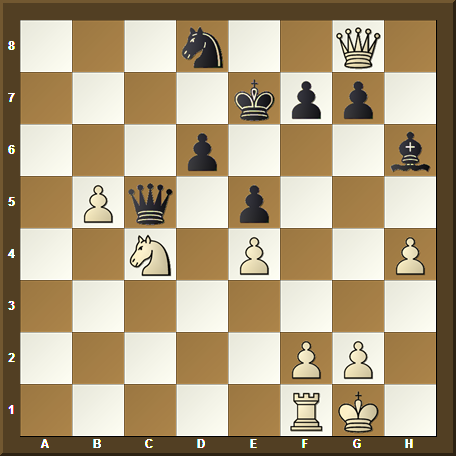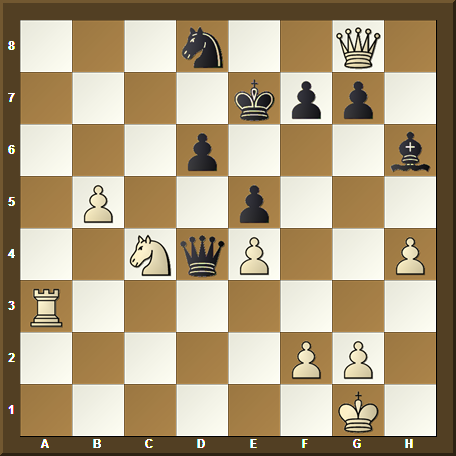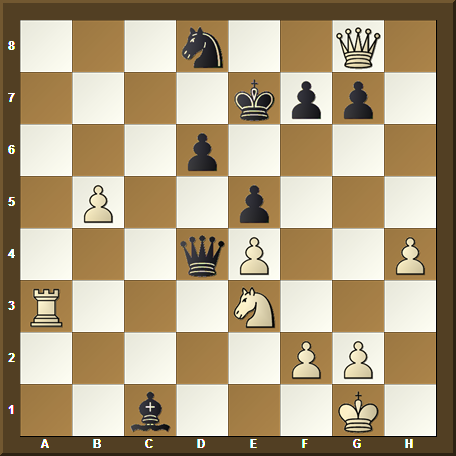All
the |
(Navigation bar
directly below.)
*******
© A.J. Goldsby, 2015.
(All rights reserved.)
****************
Click HERE
to see my
Chess Items.
****************
****************
Buy a book
from Amazon.com
(And help me out as well!)
****************
Click HERE
...
to see a list of the businesses that help to sponsor all of
my chess efforts.
According to the Internet, the above pictures date from approximately 1994, which, of course, was the year that this game was played. This tournament was a great triumph for Garry Kasparov, who won six games, drew five and lost none. (See the CT, just above.) Garry finished 1.5 points ahead of Shirov and Yusupov (Jussupow) in a world-class field. In fact, those of us old enough to remember this event know that it was an event that was simply filled with some of the best (active) players in the world ... at that time. One fact that jumps out at me, (when I look at the cross-table given above); is that GM Boris Gelfand ... played a WC Match against Anand in 2012. Korchnoi had a very good tournament ... and while someone had to finish at the bottom, just about all the games were absolutely fantastic. (I have - recently - played through just about all of these games.) Garry Kasparov's victory over Shirov was hailed as one of the greatest chess games of all time, his "positional exchange sack" was talked about (by some) as one of the finest chess concepts ever created on a chess-board. It was voted - by other GM's - as the best played game of Informant #61, it seemed that the praise for Garry's play would never cease. Yet, I had questions about this whole game when it was played, although I lacked the analytical prowess to prove my point. Fast forward to 2013 - when I first started working on this game in preparation for this web page - chess engines have become strong enough where they can defeat any human player ... and can now perhaps aid in a serious re-examination of this classic chess encounter. *********************************** I actually started on this project ... several times, definitely more than once ... but never finished. (This is something that I have done quite a bit.) I was actually looking at this game a lot in 2013, but wound up hating what I saw. As a result, I wound up deleting everything I had done before, and pulling up a fresh copy of this game from ChessBase. I also used Fritz 13, Deep Shredder and Houdini 4.0 as my primary engines. A young friend {and former student} from south Florida has the latest version of Rybka ... and a very powerful, brand-new PC. He was kind enough to do a very deep analysis of this game ... at just about all the key junctions ... and send me a copy of his work. |
|
Click HERE to see an explanation of the symbols that I commonly use when I annotate any chess game. Click HERE to replay this game. (Click HERE to see a "star-dot-pdf" / Adobe copy of my analysis.) Click HERE to see my video channel on the "You-Tube" channel. (Click HERE to see my YT video on this game.) |
GM Garry Kasparov (2805) -
GM Alexei Shirov (2740)
|
|
|
[A.J. Goldsby I]
This game has already achieved
the status of a legendary win, it was voted the best game of that particular issue of the Informant.
(Informant # 61) People have rained down praise on Kasparov's play,
yet I feel that a re-assessment of this game is in order.
The game begins with 1.e2-e4, Shirov counters with a Sicilian.
1.e4 c5; 2.Nf3 e6; 3.d4 cxd4; 4.Nxd4 Nf6; 5.Nc3 Nc6; 6.Ndb5 d6;
Black plays his QP forward one square, in order to prevent White from playing Nd6+.
7.Bf4 e5; 8.Bg5 a6; 9.Na3 b5; (… with the idea - P/b5-b4, with a fork.)
An Open Sicilian has turned into
a system with an early ...e7-e6. This - in turn - has been forced (by White) into the Sveshnikov
Sicilian, the Chelyabinsk Variation ...
This main line was all the rage in GM chess for about 20 years, and although it is still being
played today, its overall popularity has faded somewhat.
|
|
r1bqkb1r/5ppp/p1np1n2/1p2p1B1/4P3/N1N5/PPP2PPP/R2QKB1R w KQkq b6 0 10
Some of the specialists ... from the Black side of this particular opening system ... are: Carlsen, Kramnik, Topalov, Radjabov, Shirov and Gelfand.
[ A viable alternative - for Black - would be the older system of:
RR 9...Be6;
10.Nc4 Rc8; 11.Bxf6 gxf6;
12.Ne3,
"+/=" 12...Bh6;
when Black has fair play. ]
10.Nd5, (positional/slow)
In this system rather than try and immediately push Black off the board or smash his Pawn structure, White simply inserts his Knight into the strong outpost-square on d5. This sends the message that White will slowly try to squeeze Black on the light squares and push him off the chess board.
|
|
r1bqkb1r/5ppp/p1np1n2/1p1Np1B1/4P3/N7/PPP2PPP/R2QKB1R b KQkq - 0 10
The first time that I saw this move played, the (then) World Champion, GM Anatoly Karpov used it (from the White side) and won some very impressive games with it.
[A
few examples.]
[ White can also play more sharply, and immediately give Black doubled and isolated
Pawns with the following continuation: 10.Bxf6
gxf6; 11.Nd5, "+/="
11...f5;
"<=>"
when play can become wild, but both sides have a fairly good game and there are
many options to explore.
]
10...Be7; 11.Bxf6 Bxf6;
Again - we see the mostly positional concept of White removing the main defender of the d5 square - in the attempt to maintain his Knight on d5, and slowly trying to squeeze Black to death.
|
|
r1bqk2r/5ppp/p1np1b2/1p1Np3/4P3/N7/PPP2PPP/R2QKB1R w KQkq - 0 12
Recapturing with the Bishop on the f6-square is the move that is played the most often and the one that generally gets the nod from the books on this system of the Sicilian.
[ The alternative of:
RR 11...gxf6!?;
12.c3,
"+/=" 12...f5; "<=>"
gives Black doubled f-pawns, but also opens the g-file for a possible
attack by Black, later in the game.
]
Both sides continue their overall development. (c3 is crucial for the first player, as he strives to avoid ...b5-b4; and the player of the White pieces also wants to keep Black's N off of the important d4-square.)
12.c3 Bb7; (Hits e4 & d5.)
Black begins to attack the key squares and prepares the maneuver of ...N/c6-e7. However, the main line today is castling on the K-side, according to a relatively new
DVD that I have on this particular opening system. (By GM Loek van Wely.)
[
Perhaps better was: (>/=) 12...0-0; -
GM I. Stohl
Taking this line a bit further, so we can examine theory;
we have the following line:
13.Nc2 Bg5;
14.a4 bxa4; 15.Rxa4 a5;
The end of the column.
16.Bc4, (Hits d5.)
Development ... and a clear illustration of the four opening principles in action.
(RR 16.b4 Ne7!; 17.Nce3, "~")
16...Rb8; 17.b3 Kh8; 18.0-0, "+/=" (W / a small edge.)
White has a small advantage, and has scored well from this particular position.
See the game: GM V. Ivanchuk - GM M.
Carlsen; /
Tal Memorial, Moscow, 2007.
(They
drew, but it took close to 100 moves before they did!)
[ See MCO-15, page # 341; column # 07, and all notes ... especially note (e.)
Note: We have one extra move because of the way that the opening was played.
However, all of the positions are completely identical. ]
]
13.Nc2 Nb8!?; (Reason?)
This move causes quite a shift in the computer's general eval's of the overall position. It is NOT enough to label the move as inferior (dubious), as the move is both logical - Black seeks to avoid getting doubled f-pawns; and it is not an error which Black could not recover from. However, there is a fairly substantial loss of time associated with this move, and it is this loss of tempi that allows Garry's fantastic idea to work. Therefore, I can only conclude that the "book" line, (which means Black should play his Knight to the e7-square); was a small (but important) improvement here for Black.
|
|
rn1qk2r/1b3ppp/p2p1b2/1p1Np3/4P3/2P5/PPN2PPP/R2QKB1R w KQkq - 0 14
The position - above - is the one after Black's last move of 13...Nb8!?
[ The following continuation was almost certainly a small improvement over the course of the actual game:
>/= 13...Ne7; 14.Nce3, (solid)
This seems to be one of the top 'book' moves here and is also the play that is most often picked by the
majority of the stronger chess engines.
( An alternative was: 14.Nxf6+ gxf6; 15.Bd3, "+/=" - Garry Kasparov & Houdini. )
14...Bg5; 15.Nxe7
Bxe7; 16.Nd5 0-0;
17.Be2, "+/="
when White holds a small edge in this position yet the theoretical tomes give Black's set-up the seal of general approval.
See the contest of:
GM Ratmir D. Kholmov (2460) - FM Michal Horak
(2325); [B33] /
Master's (open)
Tournament / Pardubice,
CZE; (R#5) / 1994.
(Black drew a very long game ... 1/2 in 81 moves.)
]
Now just about all the engines choose Nce3 here. However, I like the text move, as it is very active, and puts Black's position under immediate duress.
14.a4!? bxa4; 15.Rxa4,
This is certainly both good and playable ... I only wish to point out that it is not the top choice of many chess engines.
|
|
rn1qk2r/1b3ppp/p2p1b2/3Np3/R3P3/2P5/1PN2PPP/3QKB1R b Kkq - 0 15
White does have a fun position here, with lots of tactical threats.
[ RR 15.Nce3, "+/=" - Fritz 13 ]
Black's next move is solid, indeed it is the first choice of most of the chess engines.
15...Nd7; 16.Rb4!?N, (N = NOVELTY / A new move for master-level praxis.)
(16.Rb4! - GM Igor Stohl.)
|
|
r2qk2r/1b1n1ppp/p2p1b2/3Np3/1R2P3/2P5/1PN2PPP/3QKB1R b Kkq - 0 16
Apparently, this was a new move at the time that Kasparov played it, and probably the whole reason that he wanted to play this line.
("New ideas - prepared at home.")
Statistically speaking, this play has scored well. However, according to the chess engines, it is not any better than the other lines, Nce3 is the choice of nearly all the strong chess engines here.
[ All of the following moves are playable and do well for White, yielding at least a solid edge:
RR 16.Nce3, "+/=" or
RR 16.Bc4, "+/=" or
RR 16.b4, "+/="
]
16...Nc5!?; (Knight outpost?)
This is a very logical move ... to which Kasparov appends the dubious appellation.
(Most of the pundits - like Iakov Damsky - recommended that Black play ...Rb8; instead.)
|
|
r2qk2r/1b3ppp/p2p1b2/2nNp3/1R2P3/2P5/1PN2PPP/3QKB1R w Kkq - 0 17
As this move does not cause a dramatic rise in the overall scores of the chess engines, and it is also a reasonable move, I cannot agree with Kasparov's harsh grading of Shirov's play at this point.
[ >/= 16...Ra7!, "=" (- Fritz & Houdini) ]
17.Rxb7!?, ('!!' - GM G. Kasparov.)
This is simply one of the most astounding moves of the 20th century of master-level praxis.
|
|
r2qk2r/1R3ppp/p2p1b2/2nNp3/4P3/2P5/1PN2PPP/3QKB1R b Kkq - 0 17
Kasparov generously awarded himself two exclams for this play, (See Informant # 61.); however, as the engines do not agree with this decision today, (03/2014); and the fact that there is no forced win from this point, I would have to say that Rxb7 was not White's best move in this particular position.
It IS a grand conception, and Black's Knight on b7 will be completely out of play for a long, long time. However, (in the long run); the sacrifice should have been good for
nothing more than a draw. (I do NOT want to gloss over this point, White is a whole exchange down, he does not even have one Pawn for the Ox, yet Garry never seems to be in any danger of losing the game! For this alone, the game is worthy of most of the attention and praise that it has received.)
Let me also say - if computers ever improve to the point that they are flawless - and a forced win is discovered ... then the move of 17.Rxb7, would deserve three ... or even four exclamation points. (However, this has not happened, so the designation of '!?" is as fair and as objective as I could possibly be at this singular point in time.)
[ Objectively, it was probably better for White to play:
>/= 17.Nce3!, "+/="
(w / advantage).
White has a small edge, and good play on the weak squares. However, Black is far from being
lost and has the kind of play that is typical for this type of Sicilian System.
]
Of course, Black must recapture.
17...Nxb7[]; 18.b4!, (Possibly - '!!')
White spurns material gain in order to keep the Black steed (on the b7-square) out of play.
The engines (all) want to play 18.Ncb4, angling for active play and possibly winning the a6-Pawn, but Garry's move is much deeper and more in the spirit of his bold exchange sacrifice.
[ Not as good would be: </=
18.Ncb4!? Nc5; 19.Qf3
Rc8; "=/+"
when Black remains up an exchange in this game.
]
18...Bg5; (Restriction.)
The point of this move is Shirov was trying to prevent Ne3-c4.
Predictably, Garry is not so easily deterred, his Knight now finds a new route to the desired destination.
19.Na3! 0-0; 20.Nc4 a5!;
(20...a5! - GM I. Stohl)
|
|
r2q1rk1/1n3ppp/3p4/p2Np1b1/1PN1P3/2P5/5PPP/3QKB1R w K - 0 21
Damsky notes that, in this position, if Black played ...f7-f5!?; he is simply aiding his opponent, and helping White's LSB get into the game in a very effective manner.
[ RR 20...Ra7!?; - Fritz 13. ]
21.Bd3 axb4; 22.cxb4 Qb8;
Black is hard pressed to find a way to gain any real activity; or find a plan that would lead to meaningful play for all of his pieces.
(Moving the BQ does free a square for the poor BN on the sorry b7 spot ... and prepares ...Nd8-e6.)
23.h4!, (Space, time, etc.)
Garry knows how to control a position, no matter what the material balance may be.
---> Here, (with h2-h4!); he hits Black's DSB with a gain of time and forces it to retreat.
|
|
rq3rk1/1n3ppp/3p4/3Np1b1/1PN1P2P/3B4/5PP1/3QK2R b K h3 0 23
"Facing Black with a dilemma, whether to immobilize his own knight after
23...Bd8; 24.g3, Qa7;
25.0-0, (...)
or to throw caution to the wind." - Iakov Damsky
[ RR 23.Ncb6, "~" - Fritz 13. ]
23...Bh6!; (Covering e3.)
"23...Bh6?" - GM Igor Stohl
The computer thinks that ...Bd8; is a better move. However, with two active White Knights ready to jump into Black's position, Shirov has to play actively to avoid a complete disaster.
[ Just one sample line ...
which shows the possible dangers of allowing two White Knights a complete free reign ...
would be the following: 23...Bd8!?;
24.0-0 Qa7; 25.Qe2 Qd4; 26.Nce3 Ra3!?;
27.Bb5 Bb6?; 28.Nf5,
'+-' and Black has trapped his own Queen.
]
24.Ncb6 Ra2; 25.0-0 Rd2?!;
Black plays his Rook into the heart of the White position. It is easy to see how Shirov could play such a move, as (at first glance) it may appear that Black is winning.
However, it turns out that this move is a total flop ... and should have lost to the surprise move of 26.Qb1!
|
|
1q3rk1/1n3ppp/1N1p3b/3Np3/1P2P2P/3B4/3r1PP1/3Q1RK1 w - - 0 26
Strangely, Garry Kasparov does not comment on this move, however Igor Stohl does correctly label Black's 25th move as inferior.
(It's even possible that ...Rd2; might have deserved an entire question mark.)
[ Better was: >/= 25...Qd8!; - GM Igor Stohl & Fritz 13. ]
Now Garry had 26.Qb1! which just might be a completely forced win for White, however, Garry missed it and Shirov was almost able to get a playable position.
(Just about all the engines do find 26.Qb1! here.)
26.Qf3!? Qa7; (Activity.)
Thus far, both players have played some excellent, hard-hitting chess.
|
|
5rk1/qn3ppp/1N1p3b/3Np3/1P2P2P/3B1Q2/3r1PP1/5RK1 w - - 0 27
This is a critical position, and Garry had to find the most accurate way to proceed from this point in the game.
27.Nd7!?, (Not the best.)
White attacks the Rook on f8 and thinks (maybe) later to play a Knight to the b6-square, causing a general disruption in the rear areas of Black's army.
However, this inaccurate play ... possibly deserving a full question mark, (but given the dubious grading by Iakov Damsky and also GM Igor Stohl) ... ... ...
will cost White most - or all - of his advantage.
[ Correct was: >/=
27.Bb5!, "+/=" (With an
advantage.)
when White has a really good game. (Kasparov threatens
Bd7-f5 or simply Bc6. Either way, he avoids the pin -
along the third rank - as in the game continuation.)
]
27...Nd8?; (Really bad!)
Shirov - perhaps tiring of this piece never having any meaningful play - has the sudden inspiration to try and quickly get in ... Ne6-d4.
However, this was incorrect and if Shirov thought that he could reach equality by returning the exchange, he was dead wrong!
(If an annotator wanted to award this Knight move TWO question marks, I would not have a big problem with that.)
[ >/= 27...Ra8; "~" (unclear) ]
Probably, Garry was tickled at this point in the encounter.
(Shirov has returned the exchange ... for no really solid reason, and White keeps the pressure on the Black King.)
28.Nxf8 Kxf8; 29.b5!,
Garry seems to be ignoring any of Shirov's threats and concentrating only on his own plans and devices.
(For me, this is sometimes a formula for a complete disaster, but Kasparov is not even human.)
|
|
3n1k2/q4ppp/3p3b/1P1Np3/4P2P/3B1Q2/3r1PP1/5RK1 b - - 0 29
"And again the Black Knight is crippled ..." - Iakov Damsky
"Material is equal again, and as White has fully retained all of his positional advantages, Black is lost." - GM Igor Stohl
[ Perhaps Shirov only expected:
</= 29.Bb1? Ne6;
"<=>"
when suddenly Black has good play ... and more one threat here.
]
29...Qa3!?; (Pin and win?)
Black was already in trouble, and I am sure that Shirov sensed this.
Nonetheless, the play of 29...Qd4; was superior to what was played in the game, after
29...Qa3;
the "eval's" more than double ...
with most of the chess engines that I used.
[ Black should have played: >/= RR 29...Qd4[]; 30.Be2!, '±' ("+/") (- Fritz and Houdini.) ]
Shirov may have overlooked Garry's next move ... (which - in some lines - threaten a quick checkmate).
30.Qf5! Ke8[]; (Forced.)
Black did not have much choice in this position, perhaps Shirov was already beginning to see the beginning of the end.
[ Much worse was:
</= 30...Rxd3?; 31.Qd7!
g6[]; 32.Qxd8+ Kg7;
33.b6,
'+-'
when Black must capture on d5 to avoid loss or a mate.
(If 33...Qb3; then simply 34.Qf6+, and
37.Ra1. +-)
]
31.Bc4, (Out of Dodge.)
Damsky remarks that if the BQ were on d4 in this position, White would not have been able to play this move.
[ </= 31.Bb1? Ne6!; 32.b6, "~" ]
31...Rc2; (hmmm)
According to Fritz, Black had to play 31...Qc5; (or even 31...Qa5); although White would still retain the clearly superior overall game.
[ Black also loses after the following line here:
</=
31...Qc5!?;
32.Qxh7! Rd4;
The box shows this as best.
( </= 32...Qxc4??; 33.Qh8+ Kd7; 34.Nb6+, ('+-') )
33.Be2! Rxd5;
(Forced?!?)
I think that Black must try to eliminate a few of White's threats here.
( Even worse would be: </= 33...Rd2?; 34.Qg8+ Kd7;
35.Bg4+ Ne6; 36.Qxf7+, '+-'
and Fritz sees a checkmate in nine more moves! )
34.exd5 Qxd5;
35.Ra1 Qd4;
36.Ra8 Ke7;
37.Qg8 Qb6;
38.Bc4, '+-'
(decisive)
when White has a completely overwhelming position.
]
32.Qxh7 Rxc4!?; (A groan.)
This looks like suicide ... (The machine prefers the move, 32...Kd7; here.).
Now Black is losing a whole Rook to a simple Knight fork, but it is not clear if (or how) Shirov could have avoided such a fiasco.
{At this point, Black only has the choice of which poison he must swallow.}
33.Qg8+ Kd7[]; (Forced.)
Haha, this is Black's ONLY legal move!
34.Nb6+ Ke7; 35.Nxc4 Qc5; (Nearly trapping the WN.)
Now the White Knight has no real escape square.
|
|
3n2Q1/4kpp1/3p3b/1Pq1p3/2N1P2P/8/5PP1/5RK1 w - - 0 36
Perhaps Shirov ... maybe already in time pressure ... has begun to think that he might be clawing his way back into the game.
If Black did believe he was getting back into the game, then White's next move must have been a real shock.
36.Ra1!, (Surprise!)
Suddenly, it is the insecure situation of Shirov's King that is the most important facet of this position.
[ Much worse was:
</= 36.Ne3?
Bxe3; 37.fxe3
Qxe3+; 38.Kh2
Qxe4;
39.Qxg7 Qxh4+;
40.Kg1 Qd4+;
41.Rf2, "+/="
(A slight
plus for the 1st player.)
White might be a little better here, but whether or not White can still win this position
is now highly doubtful.
]
36...Qd4; 37.Ra3!?, (hmmm)
With this rook play, White tries to avoid any threats to his own King.
|
|
3n2Q1/4kpp1/3p3b/1P2p3/2NqP2P/R7/5PP1/6K1 b - - 0 37
Garry was under the illusion that this was White's best move.
This is easy to understand if Garry was short of time OTB, but rather unbelievable if he did any real home analysis.
Damsky, probably just aping G.K., awards this move an exclam. However, ALL the engines agree that that Ra8! was the superior play for White in this position!!
[ Much better was: >/= 37.Ra8! Ne6!; 38.g3!, "+-" - Houdini 3.0 & Fritz 13. ]
37...Bc1!?; (Attacking the White Rook.)
Knowing Shirov, he was already in time trouble, or he had already given up on his position when he played this Bishop sortie.
However, it is a really horrible move, the scores (with some engines) literally will more than triple after this terribly errant play by Black.
(Really it should be annotated as: "37.Bc1?" Probably what happened was Shirov knew he was lost, but was simply used to making the time control at move forty before he would even consider resigning.)
[ A little better was: >/= 37...Bf4[]; 38.Ne3!, '+-' although White was still winning (fairly easily). ]
38.Ne3, "+/-" (Or '+-') Black Resigns.
(38.Ne3! - GM G. Kasparov ... >/= 38.Nxd6!, - Houdini.)
Of course, if Shirov takes the Rook on a3, then Nf5+ wins Black's Queen. ( Garry Kasparov awards his last move an exclamation mark as well, however, this seems just a little superfluous to me! {A.J.G.} Naturally, Damsky mimics Kasparov, but only because he is incapable of any original thought patterns. )
|
|
3n2Q1/4kpp1/3p4/1P2p3/3qP2P/R3N3/5PP1/2b3K1 b - - 0 38
A great game of chess to be sure, and one that has some really extraordinary ideas contained in it. Yet ... in the final analysis ... it was the poor play of Shirov, and not the brilliance of GM Garry Kasparov, that caused Black's downfall in this historic encounter.
BIBLIOGRAPHY:
(I give the following sources, in the order that I used them to annotate this game.)
***************************************************************
#1.) Informant # 61. (Game #178. ---> The Informant is from the same people that brings you ECO.)
#2.) "Chess Brilliancy," (250 Historic Games From the Masters.); by Iakov Damsky. (Game # 116, page # 162.)
#3.) Garry Kasparov's Greatest Chess Games, Volume II - by Igor Stohl (Game # 80, page # 42.)
---> I also have seen this game in many other sources, (like opening books); I cannot possibly quote all of them.
Copyright (c) A.J. Goldsby, 2014. All rights reserved.
1 - 0
The
analysis for this page was prepared with the excellent program,
ChessBase
10.0.
(I
now have ChessBase 11.0; I also used MANY different chess engines ... during the
course of my analysis!)
---> My main engines - for this game - were Fritz 13, Deep
Shredder, and Houdini 3.0.
The HTML was polished with several different tools and programs, (mostly FP) ... the text was checked for spelling with MS Word..
|
Go ... or return ... to my Home Page for this site. Go (or return) ... to my "Annotated Games" (II) Page. Go
... or return ... to my "Best
Games" Page. ******* Copyright
(c) LM A.J.
Goldsby I ******* This
page was first generated in: September,
2013. |
